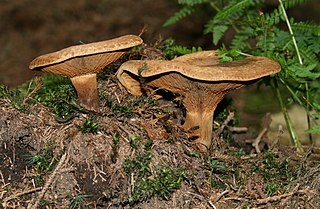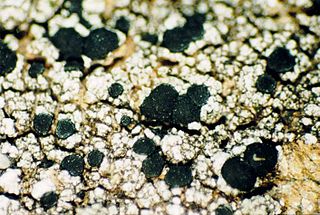
Paxillus involutus, commonly known as the brown roll-rim, common roll-rim is a basidiomycete fungus that is widely distributed across the Northern Hemisphere. It has been inadvertently introduced to Australia, New Zealand, South Africa, and South America, probably transported in soil with European trees. Various shades of brown in colour, the fruit body grows up to 6 cm high and has a funnel-shaped cap up to 12 cm wide with a distinctive inrolled rim and decurrent gills that may be pore-like close to the stipe. Although it has gills, it is more closely related to the pored boletes than to typical gilled mushrooms. It was first described by Pierre Bulliard in 1785, and was given its current binomial name by Elias Magnus Fries in 1838. Genetic testing suggests that Paxillus involutus may be a species complex rather than a single species.

Paxillus is a genus of mushrooms of which most are known to be poisonous or inedible. Species include Paxillus involutus and Paxillus vernalis. Two former species—Tapinella panuoides and Tapinella atrotomentosa—have now been transferred to the related genus Tapinella in the family Tapinellaceae

The Paxillaceae are a family of mushroom-forming fungi bearing close affinity to the boletes. Collectively, the family contains nine genera and 78 species. The type genus is Paxillus, containing fungi with decurrent gills, and Gyrodon, which has members with decurrent pores, among others. French mycologist René Maire had erected the family in 1902, placing it between the agarics and boletes and recognizing the groups' similarities with the latter group. Maire's usage of the name was later deemed to be invalid, and the genus authority is attributed to Johannes Paulus Lotsy. Molecular research confirms the relations of Gyrodon, with the decurrent-pored mushroom G. lividus, Paragyrodon, with the type species P. sphaerosporus, and Paxillus as sister groups, together lying near the base of a phylogenetic tree from which the genus Boletus arises. The name Gyrodontaceae, published by Belgian botanist Paul Heinemann in 1951, is considered synonymous with Paxillaceae.

Tapinella atrotomentosa, commonly known as the velvet roll-rim or velvet-footed pax, is a species of fungus in the family Tapinellaceae. Although it has gills, it is a member of the pored mushroom order Boletales. August Batsch described the species in 1783. It has been recorded from Asia, Central America, Europe and North America. Tough and inedible, it grows on tree stumps of conifers. The mushroom contains several compounds that act as deterrents of feeding by insects.

The Catillariaceae are a family of crustose lichens in the order Lecanorales. Species of this family have a widespread distribution, especially in temperate areas. The family was originally circumscribed by Austrian lichenologist Josef Hafellner in 1984.

The Lecanoraceae are a family of lichenized fungi in the order Lecanorales. Species of this family have a widespread distribution.

Scoliciosporaceae is a family of lichen-forming fungi in the order Lecanorales. It contains two genera, the monotypic Umushamyces, and the type genus Scoliciosporum. The family was circumscribed by lichenologist Josef Hafellner in 1984.
Adelolecia is a genus of crustose lichens in the family Lecanoraceae. The genus was circumscribed by Hannes Hertel and Josef Hafellner in 1984. The genus was formerly classified in the family Ramalinaceae, but molecular phylogenetic analysis showed it to belong to the Lecanoraceae.

Pannaria is a genus of lichen-forming fungi in the family Pannariaceae. The widespread genus contains an estimated 51 species, found primarily in tropical regions.
Cladidium is a genus of two species of lichen in the family Lecanoraceae. Cladidium was circumscribed by Josef Hafellner in 1984 with C. thamnitis assigned as the type species. C. bolanderi was added to the genus in 1989.

Hygrophoropsis is a genus of gilled fungi in the family Hygrophoropsidaceae. It was circumscribed in 1888 to contain the type species, H. aurantiaca, a widespread fungus that, based on its appearance, has been affiliated with Cantharellus, Clitocybe, and Paxillus. Modern molecular phylogenetic analysis shows that the genus belongs to the suborder Coniophorineae of the order Boletales.

The Lecideaceae are a family of lichens in the order Lecideales.

Clauzadea is a genus of lichenized fungi in the family Lecideaceae. The genus contains four species found in Europe. Clauzadea was circumscribed in 1984 by lichenologists Josef Hafellner and André Bellemère.

Austropaxillus is a genus of fungi in the family Serpulaceae, containing nine species found in Australia, New Zealand and South America.
Megalaria is a genus of lichen-forming fungi in the family Ramalinaceae. The genus was circumscribed by Austrian lichenologist Josef Hafellner in 1984, with Megalaria grossa assigned as the type species.
Robert Francis Ross McNabb was a New Zealand mycologist. He was born in Kawakawa, and attended local schools in his youth, including Whangarei Boys' High School and Southland Boys' High School. He received a BSc degree from the University of Otago in 1956, and two years later an MSc for his work on mycorrhizae morphology in native New Zealand plants. In 1961, having been awarded a National Research Fellowship the year before, McNabb left New Zealand for the UK to study with Cecil Terence Ingold at Birkbeck College. McNabb earned a PhD in 1963; his thesis was titled "Taxonomic studies in the Dacrymycetaceae". He was jointly awarded the Hamilton Memorial Prize in 1966 from The Royal Society of New Zealand, the same year he was appointed to the editorial board of the New Zealand Journal of Botany. Most of McNabb's later publications, largely published in this journal, were about fungal taxonomy. Fungus species named in honor of McNabb include Paxillus mcnabbii, and Entoloma mcnabbianum.
Egon Horak is an Austrian mycologist who has described more than 1000 species of fungi, including many from the Southern Hemisphere, particularly New Zealand and South America. He was an executive editor of the scientific journal Sydowia from 1975 to 1989, and a member of the editorial board afterwards.
Gyrodon ripicola is a bolete fungus in the family Paxillaceae. Found in Singapore, the species was first described in 1971 by E.J.H. Corner as a species of Paxillus. Pegler and Young transferred it to the genus Gyrodon in 1981.
Conocybe velutipes is a species of mushroom in the Bolbitiaceae family. It contains the psychedelic alkaloids psilocybin and psilocin.
Josef Hafellner is an Austrian mycologist and lichenologist. He was awarded the Acharius Medal in 2016 for his lifetime contributions to lichenology. Before his retirement, he was a professor at the Karl-Franzens-Universität in Graz. Hafellner started developing an interest in lichens while he was a student at this institution, studying under Josef Poelt. He earned a master's degree in 1975 and a PhD in 1978, defending a doctoral thesis about the genus Karschia. In 2003, Hafellner received his habilitation. By this time, he had studied with French lichenologist André Bellemère (1927–2014) at Saint-Cloud, where he learned techniques of transmission electron microscopy and how their application in studying asci could be used in lichen systematics. His 1984 work Studien in Richtung einer natürlicheren Gliederung der Sammelfamilien Lecanoraceae und Lecideaceae has been described as "probably the single most influential publication in lichen systematics in the latter half of the 20th century".










